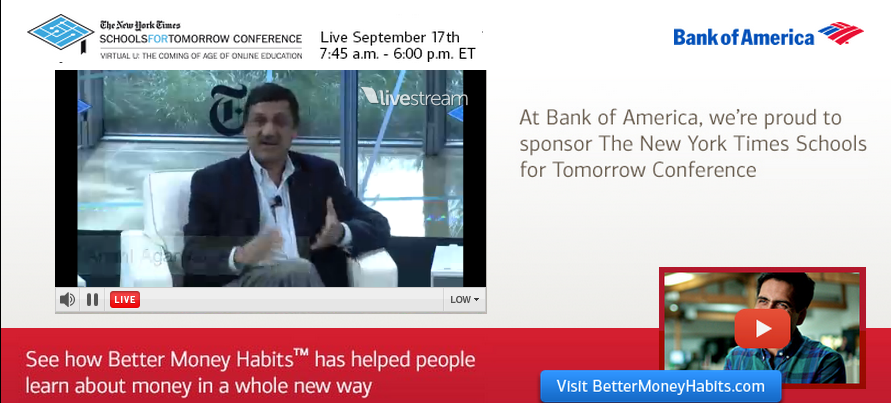
Three years ago, YouTube started putting live video in banner ads. Since then, the practice has become more common, and today The New York Times joined in with an interactive ad unit on Tuesday that marks the first time the paper has live streamed one of its own conferences in an ad.
Visitors to the Times homepage were presented with a live stream of its “Schools for Tomorrow”conference, about the rise of the open online courses at colleges and universities, sponsored by Bank of America. The new ad is reflective of a broader tendency at the paper towards recasting the lowly banner ad in new, and hopefully innovative ways.
“It’s a nice representation of marketer’s interest in being associated with content and using that content in their own messaging,” said Meredith Levien, evp of advertising at the the Times. “The fact we’re using technology to make the conference accessible to more people, and using an ad unit to make it accessible, is an elegant ribbon tied around the whole program.”
The ad is an expandable unit, starting at 970 x 250 and balloons to 970 x 418. It’s a homepage takeover. Click on the ad and a video pops up of the live stream. Bank of America’s messaging surrounds the video. (The event could also be watched live at livestream.com.)
This isn’t exactly a new thing. Publishers like YouTube and AOL have been live streaming content in ad units for a couple years now. Google even has a product called Lightbox, which live stream events inside the ad unit. For example, at May’s Federated CM Summit, Google display chief Neal Mohan highlighted how his presentation at the event was being live streamed in the ad unit at the conference’s homepage.
The ad unit is part of a bigger bank package involving sponsorship of the conference and run of site ads. There was also a private reception with Bank of America last night, and the bank was part of a breakfast panel kicking off the conference. Levien wouldn’t discuss pricing other than to say that “this partnership was a high value partnership in significant scale.”
Levien said that the Times went to the bank with the idea of running a live stream of the conference in a banner ad on the homepage. The New York Times built the unit with Bank of America and design shop Pickle Group. The program was sold just before she started in July.
“This is one of those perfect confluence of where everyone’s interests would be served at the conference,” Levien said. “It’s the ideal conference for them to be part of the conversation and the ad unit was ideal way to showcase that.”
The Times has worked diligently to rethink, the banner ad. Through its Idea Lab, the company has developed several different ad units that go beyond the typical banner. For example, last year it ran an interactive ad for Prudential that invited users to type in their birthdays to see the Times front page from that day.
The paper will be undergoing a site redesign early next year and a number of the Idea Lab’s new units will roll out with the facelift. It is, in part, a concession that in order for the Times to generate revenue from the commodity banner, it needs to constantly reinvent its approach to the ad.
“There’s two ways we look at this: one is newsroom innovation at scale and how to apply that to solve a marketer’s problems,” Levien said. “Separately, solving marketer objectives with new thinking. [The BoA ad unit] falls into the second one. It’s a discussion about financial education quite broadly.”
More in Media

WTF is behind the explosion of faceless creators?
Brands are rapidly increasing their spending on faceless creators, showing the unique benefits of working with this type of influencer.

In Graphic Detail: As ‘Grow a Garden’ booms, a new report shows the marketing power of Roblox
The explosive growth of “Grow a Garden” has brought new attention to Roblox — and rejuvenated marketers’ interest in its advertising power.

Brand deals surge for golf creators as the sport’s popularity spikes
Golf is booming, and so is influencer marketing. As a result, golf creators are signing an unprecedented number of brand deals in 2025.





